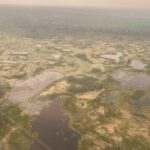The Environmental Protection Agency (EPA) held hearings Tuesday, July 29th 2014to gauge public reaction of a White House plan to reduce carbon-dioxide emissions over the next 15 years. The EPA held these meetings in three cities: Washington, D.C., Atlanta and Denver.
Also in Denver on that same Tuesday were officials from another federal agency focusing on air quality in the U.S. In fact, researchers from NASA’s DISCOVER-AQ mission have been in Colorado for weeks collecting air pollution data.
DISCOVER-AQ, which stands for Deriving Information on Surface conditions for Column and Vertically Resolved Observations Relevant to Air Quality, is a project that measures air pollution at various altitudes in regions across the country.
Researchers mainly use ground monitors and satellites to collect air quality data. This information is often disconnected between the two types of devices, however, and presents problems for understanding air quality.
Satellites, for example, don’t look at pollution near the Earth’s surface, and have difficulty determining whether pollution is high or low in the atmosphere.
“The main goal is to try to understand how we can better use current and future satellites for air quality purposes,” said Dr. Christopher Loughner, a research associate at the University of Maryland’s Earth System Science Interdisciplinary Center. “A lot of these instruments measure the whole atmosphere, but from an air quality stand point, humans really care about what we breathe and how healthy is the air.”
DISCOVER-AQ researchers have conducted field campaigns in four different locations since 2011 in order to accomplish the mission’s goals. These locations include the Baltimore-Washington corridor, California’s central valley, Houston and now Denver.
During each campaign, a series of planes fly in predetermined circuits around the testing site and collect air quality data.
“One aircraft, the P-3B, flies at low altitude,” Clare Flynn, a University of Maryland atmospheric and oceanic science graduate student, said. “The P-3B spirals over surface air quality sites, meaning it spirals up or down in altitude over that site to get a vertical profile of air quality over that site.”
“A second aircraft, the B200, flies only at high altitude since it carries different instruments, and gets a curtain of data along the flight path below the aircraft,” Flynn added.
The DISCOVER-AQ team also collects air quality data with mobile ground labs and balloons equipped with sensory instruments. Researchers then analyze this data and the aircraft data, and try to establish how they connect with one another.
This process is often easier in theory than in practice, though, as researchers must accrue a wide range of data while also working around natural obstacles.
Loughner who along with Flynn, is part of DISCOVER-AQ’s forecasting team stated that the “main problem is clouds. “If it’s cloudy, we won’t fly,” Loughner said. “Even during a flight, sometimes there could be a thunderstorm … so we would have to reroute the aircraft to fly somewhere else.”
Fortunately for NASA researchers, the overall mission has suffered few hiccups and has aided in better understanding of national air quality.
For example, Loughner and fellow researchers analyzed DISCOVER-AQ data on the bay breeze, an air pattern that causes pollution to converge around the Chesapeake Bay, during the mission’s Maryland campaign.
What they found was a lifting motion in the Chesapeake Bay air that lifted bay breeze pollution up through the atmosphere, according to Loughner. At a high enough level, air currents carried this pollution downwind to New England.
These findings showed how New England receives some of its air pollution and how interconnected different regions are with regards to air quality. As the project concludes its final campaign, researchers are looking forward to finding even more applications of the data.
“So many different groups are doing so many great and interesting things with the [DISCOVER-AQ] observations,” Flynn said. “Fortunately, the wealth of data we’ve have collected over the years will keep us busy for some time.”






